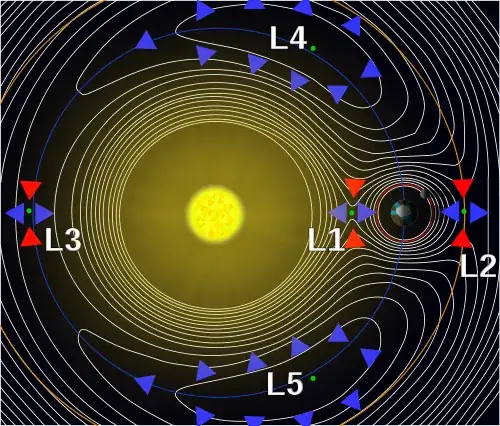I'm writing a novel and I'm quite confused if this system could be possible in the real universe. Is it possible that a system exist, where 5 identical planets which could be of same characteristics (Inclination, speed, planetary mass and others) revolve around a single star. Also, What effects would the 5 planets undergo if they are so close? (including the climatic changes and the gravitational, magnetosphere interference.)
4 Answers
No more than two objects in co-orbital configuration have been observed so far. It'd be easy if there existed atleast one satellite (instead of a planet) to one of the planets orbiting around the star. The reason I say this is because, the orbital configuration of the planets can then be thought of as Lagrangian points.

Though the L1, L2 and L3 are much less stable compared to L4 and L5, we can infer now that atleast 4 bodies can orbit the star. By this way, we can declare that they share their orbit. Still, the configurations are less likely. A slight perturbation can modify their orbit or sometimes (if unlucky), slam one onto the other...
But it's OK to say that five planets can orbit at the same time. As dmckee and John said, Klemperer rosette might be a good start. Be sure that you still maintain the symmetry (very necessary in Physics) (i.e) a triangle in case of 3 objects, a pentagonal configuration in case of 5, etc...
IIRC, this system is very very rare. As I've told already - during a planetary formation, it's still very unlikely that such a system (with more than three co-orbital config) can be formed.
- 323
- 9,178
At least according to these numerical simulations by Bob Jenkins, systems with a small number of equal-sized planets orbiting a massive central body can, in fact, be "stable, in an odd sort of way."
Specifically, the planets do not stay equally spaced around the star, even if they start out (approximately) that way. Rather, they appear to move along their shared orbit on complicated, and likely chaotic, horseshoe-like orbits, while still maintaining an approximately circular shared orbit around the sun and a surprisingly well defined minimum separation between each other.
It should, of course, be noted that these simulations are only suggestive, but not conclusive. I'm not aware of anyone having simulated such as system for periods comparable to the age of solar system, nor of any analytical results on its long-term stability. If you know of any such studies, please tell me!
- 14,306
I don't have a definitive reference for this, but I'm fairly certain such configurations are unstable to small perturbations. That means the slightest deviation from perfect symmetry will grow and the planets will collide or eject each other into different orbits. The planets could only share an orbit if their prelative positions were being actively maintained.
The Wikipedia article on Klemperer rosettes agrees that they are unstable, but doesn't provide a good reference either.
- 367,598
Possible but it would need an exceptional stable star and planetary system.
As someone mentioned before, its so improbable, its practically impossible. If a system like this did exist, then it would almost certainly be made by some advanced ancient civilisation.
It wouldn't take a massive amount to start introducing instabilities to the system as well, which would probably amplify themselves.
- 1